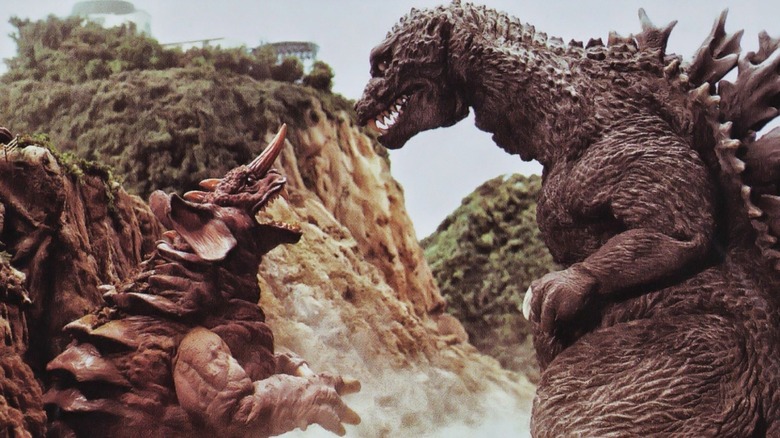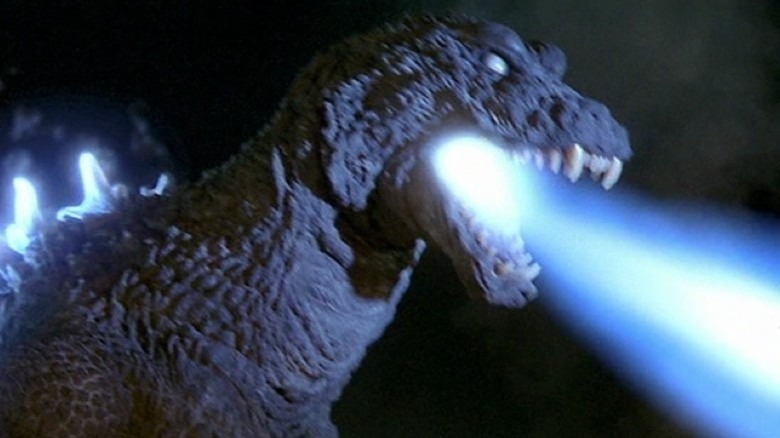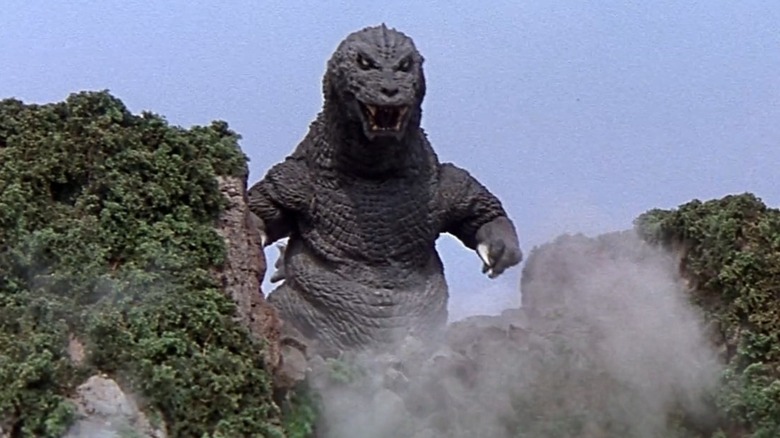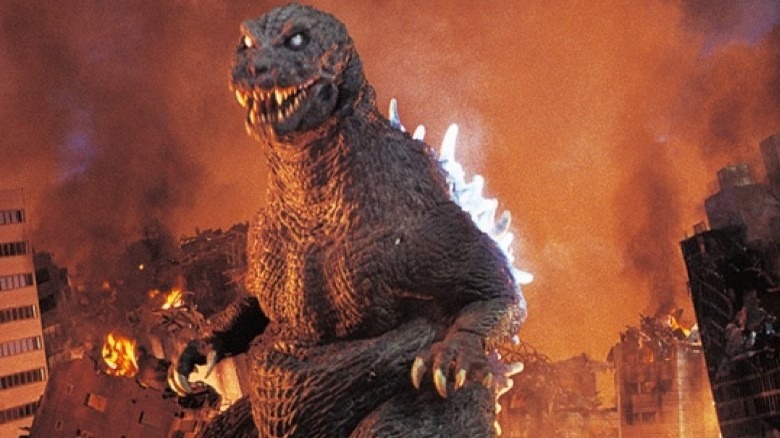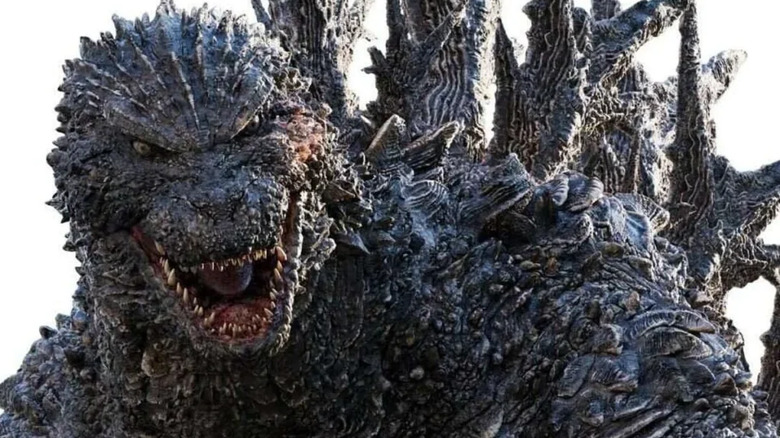What Happened To 'Godzilla GMK' - The Creepiest King Of The Monsters Explained
Godzilla has had many different incarnations over the years, ranging from the silly monster suits of the Showa Era films to the hulking CGI monstrosity that terrorizes "Godzilla Minus One." There have been anime versions (some smaller, some over 300 meters tall), American versions (though we don't talk about one of those), and little babies. Most of the time, his atomic fire breath is blue, but other times, it's orange, like in "Godzilla 2000," or even red, like at the end of "Godzilla: Final Wars."
One of the biggest variables that changes between different iterations of the character is his status as a protagonist or antagonist. The original 1954 film introduced Gojira (his name in Japanese) as a force of wanton destruction — the violence of the atomic bomb made flesh. But for most of his Toho outings — and in Hollywood's MonsterVerse — the King of the Kaiju has been portrayed as a protector of the natural world. But that's far from the case in 2001's "Godzilla, Mothra and King Ghidorah: Giant Monsters All-Out Attack."
The third entry in Toho's Millennium Era series of Godzilla movies, "GMK" (as the fans have dubbed it) is a pretty familiar monster romp in most ways. As the title implies, it pits Godzilla against Mothra, King Ghidorah, and Baragon. The twist is that Godzilla is the villain — a crazed, rageful behemoth possessed by the restless spirits of the dead (yes, really). It takes the combined might of the other three kaiju to take "GMK" Godzilla down, and even then, he isn't gone for good.
What is GMK Godzilla and how is he different?
The first two Godzilla films in the Millennium series, "Godzilla 2000" and "Godzilla. Vs. Megaguirus," both feature pretty traditional interpretations of the King of the Monsters. He's a force of nature that lays waste to cities and kills plenty of innocent people, but he also ends up defeating larger threats to humanity. He's not exactly the hero you'd hope for, but he's far from the villain.
In "Godzilla, Mothra and King Ghidorah," that changes completely. The film acts as a soft reboot that only takes the original 1954 film as canon. After a nearly 50-year absence from the world, Godzilla reemerges with a vengeance and besieges Japan once again. The film takes a more spiritual approach than most Godzilla movies, explaining that the kaiju's enhanced rage is the result of a kind of possession. As explained in the film, the souls of all the lives lost in the Pacific Theater of World War II have been channeled into Godzilla, causing him to lash out even more violently than before.
His teeth are sharper, his roar is louder, and his eyes are a ghostly white all the way through. He looks like a demon pulled out of the underworld and sent to torment Japan, which is essentially how the film portrays him. Because the people of Japan have chosen to "forget" the violence and bloodshed of the Pacific Theater, the dead have returned through Godzilla to remind them and take vengeance. The big guy even gets a bangin' new musical theme to signify his dark shift.
How powerful is GMK Godzilla?
Simply going off the terror factor and body count, "GMK" Godzilla ranks as one of the beast's most powerful incarnations. He lays waste to Baragon with no difficulty, shreds Mothra into nothing, and manages to defeat a powered-up King Ghidorah despite his opponent being assisted by the Japan Self-Defense Forces.
Consider this: "GMK" Godzilla is so strong and terrifying that the filmmakers made King Ghidorah a good guy. Ghidorah — the de facto antagonist of the entire Godzilla franchise for most of its existence — is the only monster strong enough to stand toe-to-toe against this version of Godzilla. Usually, the three-headed dragon is portrayed as an alien invader, but in "GMK" he's an ancient dragon called upon to defend Japan, referred to as a "guardian monster" alongside Mothra and Baragon. It's Ghidorah's only real stint as a hero in the franchise, and it's fun to cheer him on for once.
Still, Ghidorah proves no match for Godzilla, even after Mothra imbues him with the remains of her power. "GMK" Godzilla might not quite be at the level of more extreme versions like the anime Godzilla Earth or the Lovecraftian nightmare in "Shin Godzilla," but he's just about as strong as the rubber suit incarnations of the kaiju have ever been.
How does GMK Godzilla die?
Godzilla vanquishes all three guardian monsters by the end of "Godzilla, Mothra and King Ghidorah," but he still falls. After he kills Ghidorah, the spirits of the three guardians launch a final attack against Godzilla, which makes him just vulnerable enough for a killing blow. A JSDF submarine manages to get inside Godzilla underwater and fire a rocket drill through an open wound from the inside, ripping a hole in Godzilla's neck.
Enraged, the monster tries to charge up his atomic fire breath again, but the wound disrupts it, causing Godzilla to blast himself instead of the humans he's chasing. A second attempt has even more dramatic consequences, sparking a nuclear explosion within Godzilla that destroys him — but not for good.
In a closing shot, we see Godzilla's radioactive heart continuing to beat underwater. Given his notorious healing factor, it's implied that he will regenerate and return once again to threaten Japan. But since "GMK" never got a proper sequel, that cliffhanger ending has been left dangling ever since.
GMK Godzilla directly inspired Godzilla Minus One
Contains spoilers for the ending of "Godzilla Minus One"
Though "Godzilla, Mothra and King Ghidorah: Giant Monsters All-Out Attack" never got a sequel, it did serve as inspiration for one of the most critically acclaimed Godzilla movies ever made. In 2023, Toho returned the kaiju to his post-World War II roots with Takashi Yamazaki's "Godzilla Minus One," a film that the writer-director has said was directly inspired by "GMK."
"My favorite movie would definitely be the first, original 'Godzilla,' and then after that would be 'Shin Godzilla' and 'GMK,'" Yamazaki said when asked by Daily Dead about his history with the franchise. Speaking at a Japanese screening of "GMK" organized by Yamazaki as part of the build-up to "Minus One," he said that he had been "quite influenced" by the 2001 movie (via Movie Walker Press). That influence is evident in the storylines of the two films.
Just as in "GMK," the Godzilla of "Minus One" is violent and full of rage. He embodies the grief and destruction wrought by World War II and channels those negative emotions into a brutal campaign against Japan. And just like in "GMK," he is ultimately defeated by a small human craft that gets inside the kaiju, opening a latent wound. Once again, Godzilla destroys himself by launching a misdirected blast of atomic fire. Even the final shot at the end of "Godzilla Minus One" mirrors that of "GMK," revealing a chunk of Godzilla's decimated body regenerating at the bottom of the sea.
